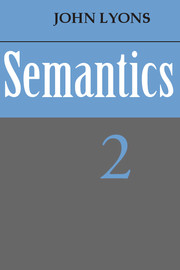Book contents
- Frontmatter
- Contents
- Figures
- Typographical conventions
- Preface
- 10 Semantics and grammar I
- 11 Semantics and grammar II
- 12 Semantics and grammar III
- 13 The Lexicon
- 14 Context, style and culture
- 15 Deixis, space and time
- 16 Mood and illocutionary force
- 17 Modality
- Bibliography
- Index of subjects
- Index of personal names
12 - Semantics and grammar III
Published online by Cambridge University Press: 05 June 2012
- Frontmatter
- Contents
- Figures
- Typographical conventions
- Preface
- 10 Semantics and grammar I
- 11 Semantics and grammar II
- 12 Semantics and grammar III
- 13 The Lexicon
- 14 Context, style and culture
- 15 Deixis, space and time
- 16 Mood and illocutionary force
- 17 Modality
- Bibliography
- Index of subjects
- Index of personal names
Summary
Kernel-sentences and sentence-nuclei
We are assuming throughout this work the validity of transformational grammar and its universal applicability for the syntactic analysis of natural languages. We are not committed, however, to any specific formalization of transformational grammar (cf. 10.3); and in this section as elsewhere in the book, we shall be somewhat eclectic in the use that we make of the terminology and concepts associated with particular systems of transformational analysis.
One notion that we will appeal to is that of the kernel-sentence. Two rather different conceptions of kernel-sentences have been formalized in transformational grammar: one by Harris and the other by Chomsky. For Harris, a kernel-sentence is a sentence that is not derived from any other sentence (or pair of sentences) by means of a transformational rule; for Chomsky, as he originally defined the notion, a kernel-sentence is one that is generated in the grammar without the operation of any optional, as distinct from obligatory, transformations. In later versions of Chomsky's system, in which the role of optional transformations has been greatly reduced, the notion of the kernel-sentence has lost much of its original significance; and kernel-sentences, as such, play no part in either the generation or interpretation of sentences (cf. Chomsky, 1965: 18). Nevertheless, kernel-sentences are still definable in Chomsky's system (though not as simply or as elegantly as before).
The difference between these two conceptions of kernel-sentences need not concern us. It largely depends upon the way in which transformations are defined in the two systems of formalization.
- Type
- Chapter
- Information
- Semantics , pp. 467 - 511Publisher: Cambridge University PressPrint publication year: 1977



